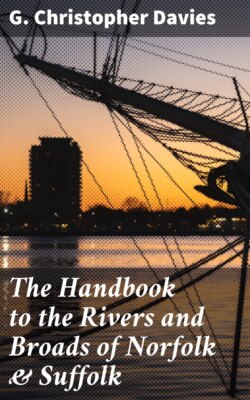Читать книгу The Handbook to the Rivers and Broads of Norfolk & Suffolk - G. Christopher Davies - Страница 6
На сайте Литреса книга снята с продажи.
CHAPTER III.
REEDHAM TO YARMOUTH.
ОглавлениеTable of Contents
The next morning we were up betimes to take the last of the ebb down to Yarmouth, and catch the tide up the Bure. As there was a fresh breeze from the east, we had to tack nearly the whole of the way.
At Reedham there is a swing bridge, over which the railway passes, and if the wind is foul it is always a difficult matter to sail through, particularly if the tide be against you. On the present occasion we had the tide with us; therefore, on reaching the opening of the bridge, we could shoot the yacht up into the wind, and carry her way on until through, when her head was paid off on the proper tack.
“I tell you what, these Norfolk waters are capital places to learn to steer in. An inch either way, and we should have torn our sail against the bridge.”
“Yes, and what with getting the utmost on every tack, without going ashore, shaving wherries by a yard or two, and watching for every puff as it comes over the grasses on the marsh, so as to make the most of it, there is more fun in sailing here than on more open waters.”
Just below the bridge is the New Cut, a perfectly straight canal, three miles long, connecting the Yare with the Waveney, and so saving a round of some eighteen miles, which would otherwise be necessary to get from the one river to the other, as a reference to the map will show.
Now came a steady beat for several miles, until we reached the Berney Arms (on the right is the mouth of the river Waveney), when Breydon water opened out before us, with Yarmouth in the distance. When the tide is in, this is a remarkable sheet of water, four and a-half miles long by a mile broad. There are mud flats on either side of the wide channel, where herons and sea-fowl greatly congregate. The strong wind against the tide raises a respectable sea, and the tacks being longer we made rapid progress, and the motion was exhilarating. A sail across Breydon in a strong wind, is a thing I always consider a great treat. The channel is marked out by stout posts at intervals of two hundred yards or thereabouts, but it is not safe to sail too close to all these posts unless the tide be high, as the shoals stretch out beyond them, and, in default of local knowledge, it is best to give them a wide berth.
The spires of Yarmouth grow more distinct, and at last we arrived at its quays, just as the tide was on the turn. We made fast alongside a wherry moored to the quay, and while our man, with the assistance of one of the loiterers on the quay, lowered the mast, and quanted the yacht up the narrow mouth of the Bure and under two bridges, we took a stroll about the quays, the quaint “rows” and streets of the old part of the town, and had a peep at the splendid church.
The ebb tide runs very strongly, and, to avoid being carried against the bridge which spans the contracted harbour, it is prudent for the stranger to have an anchor in readiness. The public quays are on the north side next the town, and a berth alongside a wherry or other yacht can be chosen. There are private moorings laid down alongside the south shore off “Cobholm Island,” and it is customary, in case of need, to bring up to one of these, if vacant; but a yacht must not be moored there, or alongside another yacht there, without permission. If the visitor is nervous or inexperienced, he can avail himself of the services of one of the watermen loafing about the quays, to help him through the fixed bridges which block the entrance to the river Bure, which here enters the harbour.
The river bends to the south at an acute angle with its former course, and for about three miles runs very close to, and almost parallel with the sea. It is interesting to row past the wharves and quays, where many quaint and picturesque bits present themselves, but on account of the rapid flow of the tide, it is not a part of the river much frequented by the river yachts.
As Yarmouth has guide-books all to itself, it is not necessary here to expatiate upon its attractions.
